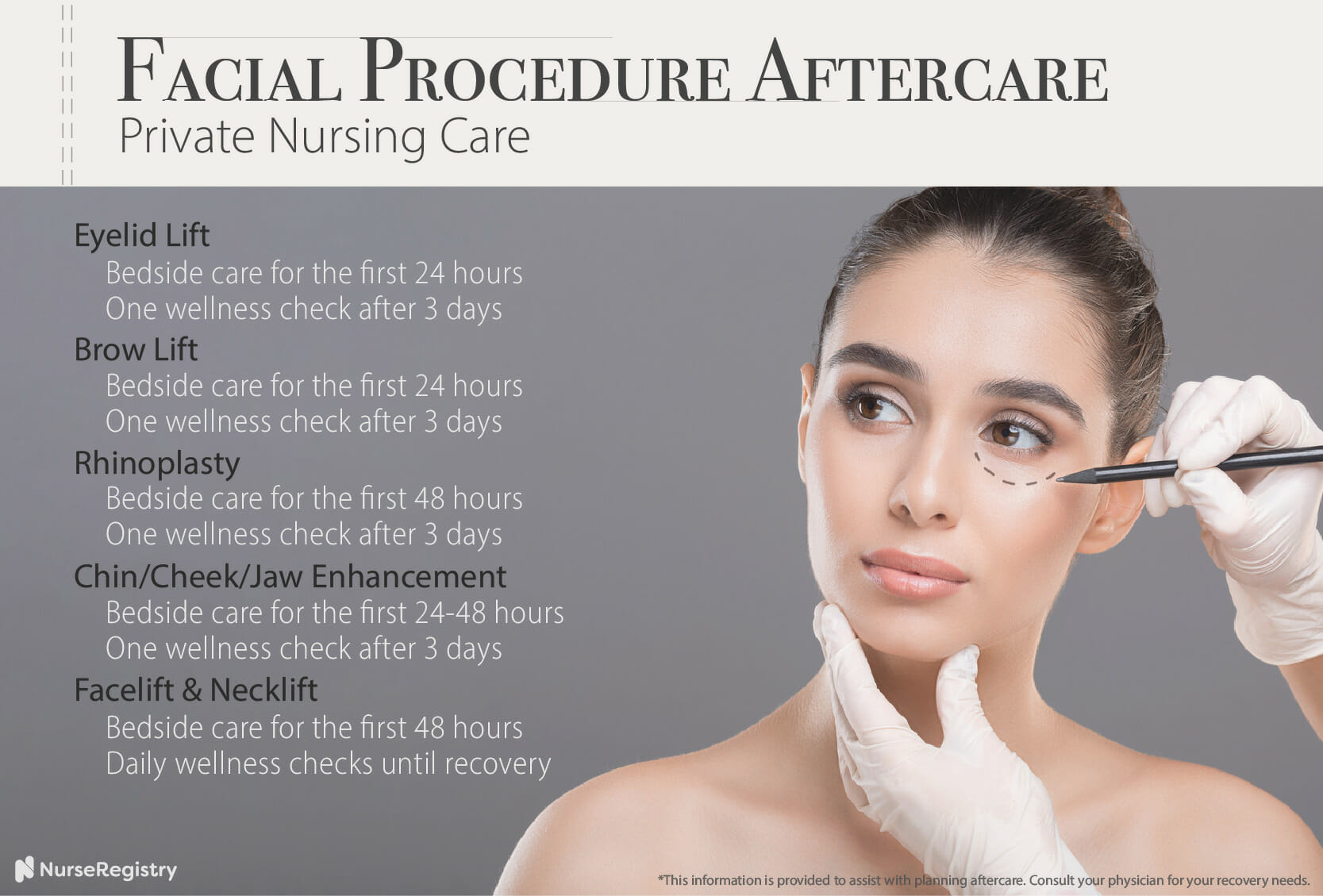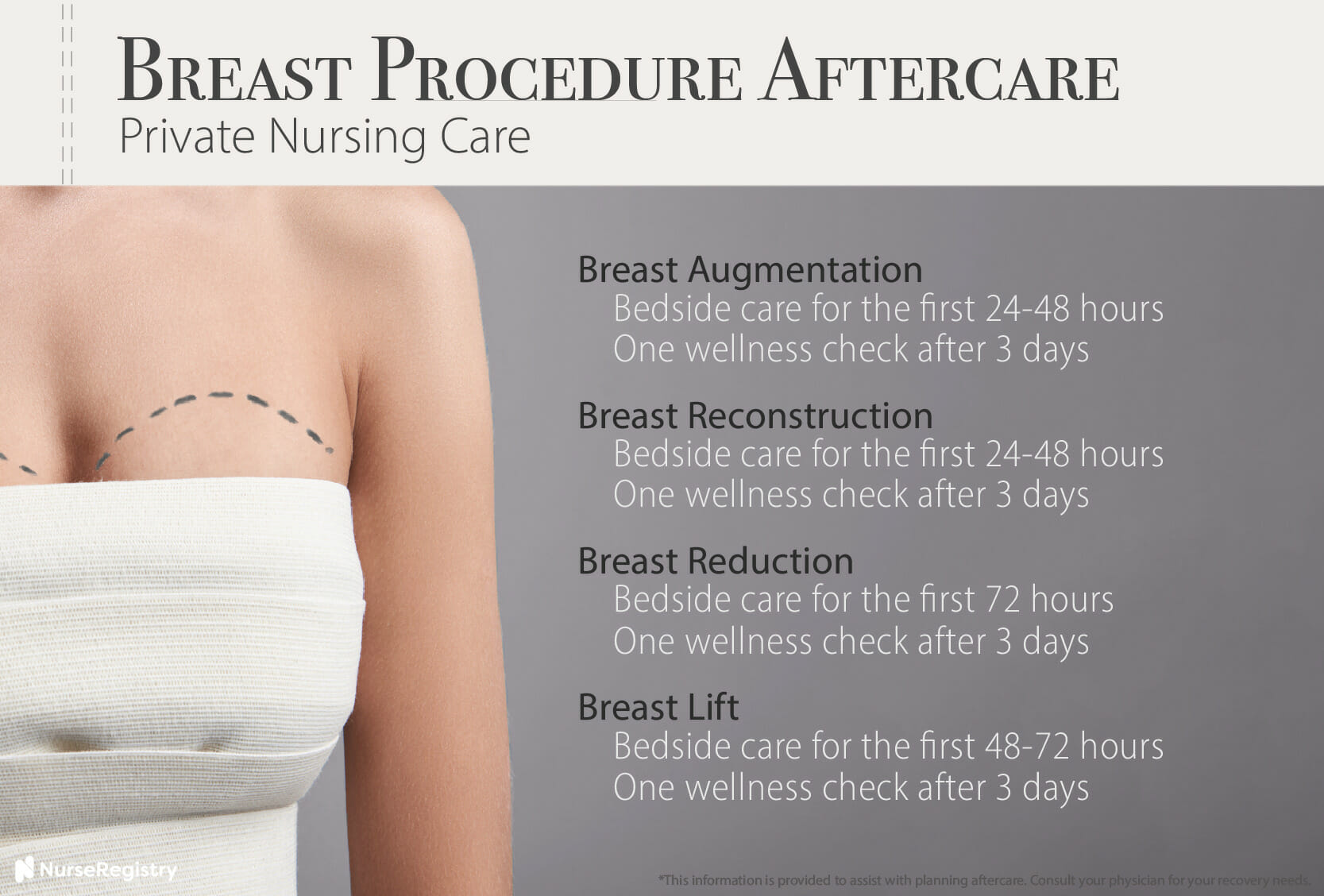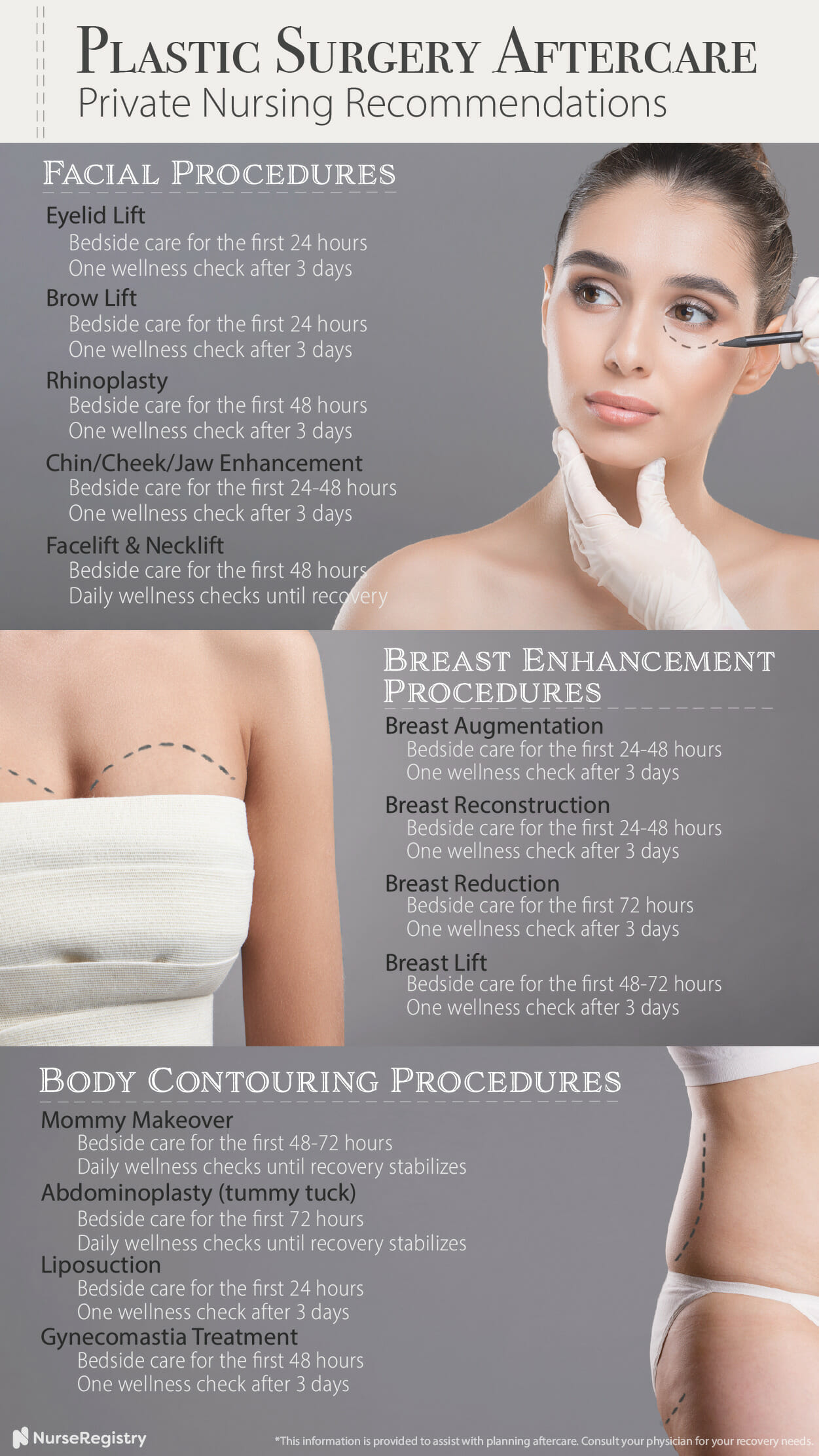Every day we get calls from patients about to undergo plastic surgery and looking to hire a private nurse for aftercare as they recover.
Based on hundreds of nurse visits, we’ll give you the inside scoop on why people are hiring private nurses.
For decades, plastic surgery has been changing people’s lives and nurses have been standing by patients helping them on their paths to happier lives.
Postop or aftercare nurses assess and manage all aspects of recovery: pain management, emptying drains, changing wound dressings, applying heat/cold packs or compression garments, and acting as a liaison with the physician to update prescriptions and care instructions, as necessary.
| In This Article |
|---|
| Facial Procedures |
| Breast Enhancement Procedures |
| Body Contouring Procedures |
| Postop Aftercare |
Why do people hire a private nurse for Cosmetic Surgery Recovery?
IN THIS ARTICLE
The best way to come out of surgery is with a support system in place. With a nurse by your side to follow the surgeon’s instructions and ready to make changes to the recovery plan, you can rest assured that you’re on the path to a successful recovery.
So while plastic surgery aftercare facilities or plastic surgery recovery centers are fantastic places to get 24/7 specialized care, patients prefer to hire a nurse for a day or daily check-in visits to their home, or hotel, in the case of medical travel out of town or state.
Private nurses significantly make life easier and more convenient after a cosmetic surgery procedure. An in home nurse can also increase your chances of a seamless, speedy recovery.
The privacy, being surrounded by loved ones, and savings are all extra reasons why patients prefer to hire a private nurse for postop care, but the main reasons are the ones that follow: pain management, wound care, and comfort.
Pain Management
Like the butterfly emerging from the cocoon, the most difficult part for patients is emerging from the cocoon, aka post-op.
During the cosmetic procedure, you feel nothing, and later you’re like the beautiful butterfly flying carefree.
But, the recovery process can be extensive and painful.
In the middle of the night, I woke up to sharp pain. The nurse took over, she called the doctor, had my prescription changed, had the new meds delivered. If it weren’t for her, I wouldn’t have made it through that first night.” -Rhinoplasty patient
The most common concern among plastic surgery patients is managing the pain and discomfort after the procedure.
Nurses have extensive experience and ways to minimize swelling and discomfort. And, they know when it’s time to call the doctor to change the prescription.
Wound care
Wound care is not for the faint of heart. Proper wound care is important for reducing infections and scarring.
I’d been through childbirth more than once, so I figured I could handle anything. My husband insisted we hire a nurse for wound care after the mommy makeover. He was right, the drainage was beyond me. The nurse put me at ease. I knew everything was being done exactly to the doctor’s orders. In the end, the scarring was minimal.” -Karen M.
With skilled experienced postop nurses after surgery care is taken care of precisely as the doctor ordered.
Comfort
There’s an underlying comfort in being home with loved ones and maintaining your normal lifestyle. Hiring a private nurse to ensure high-quality medical care while maintaining privacy yields ideal results all around.
In-home care remains the leading choice for plastic surgery aftercare.
How Long Does Plastic Surgery Take to Heal?
When it comes to healing and cosmetic surgeries, it depends on the exact procedure and how our bodies respond to them. Having a private duty nurse by your side throughout the recovery process can be helpful.
Continue reading below to discover the expectations you can set for individual cosmetic surgeries, along with the procedure itself and recovery time.

How long is the plastic surgery recovery process for facial procedures?
Similar to body contouring procedures, facial procedures range in healing time from a couple of weeks to a couple of months. Some may even take a full year to recover sensations in the face. Here is a variety of facial procedures and what their healing processes look like.
Eyelid Lift
Procedure: An eyelid lift can correct the looseness and sag that happens to the tone and shape of eyelids over time. The surgeon will remove extra fat, muscle, and skin from both the upper and lower eyelid to correct the shape of each eye.
This is a common eyelid surgery.
Aftercare: Eye drops and facial bandages are common.
Post-Op Private Nurse: Medication administration, monitor for swelling/bleeding, assessment and correspondence with physician regarding complications (bleeding, infection, out of proportion swelling), pain management
24/7 Care: First 24+ hours
Wellness checks: 1x after 3+ days
Recovery: Eyelids may feel sore or tight for just two weeks after surgery. Return to normal activities can be expected within just 10 days after the procedure.
*Patients should talk with their surgeon about their recovery plan. People heal at different rates and should expect recovery plans to be adjusted accordingly.
Brow Lift
Procedure: This surgical procedure involves the removal of excess fat and skin, and tightening of muscles located in the forehead region. The procedure can correct a forehead that is sagging or one that has deep furrows between the eyes. Oftentimes it is done in conjunction with a facelift.
Aftercare: Eye drops and facial bandages are common.
Post-Op Private Nurse: Medication administration, monitor for swelling/bleeding, assessment and correspondence with physician regarding complications (bleeding, infection, out of proportion swelling), pain management
24/7 Care: First 24+ hours
Wellness checks: 1x after 3+ days
Recovery: The initial healing of the wound only takes around two weeks. It does take several months for a complete recovery.
*Patients should talk with their surgeon about their recovery plan. People heal at different rates and should expect recovery plans to be adjusted accordingly.
Rhinoplasty (nose job)
Procedure: Nose reshaping enhances the facial harmony and proportions of the nose. It may also correct impaired breathing caused by defects in the structure of the nose.
Aftercare: A splint or packing may be placed inside the nose, and another splint may be placed on the outside to support the new structure during the healing process. One of the more painful procedures, it is commonly accompanied with breathing and eating or swallowing difficulties during the initial recovery periods.
Post-Op Private Nurse: Application of medications, continual assessment, and correspondence with physician regarding complications (bleeding, infection, out of proportion swelling), pain management
24/7 Care: First 48+ hours
Wellness checks: 1x after 3+ days
Recovery: The swelling will go away after a few weeks. In terms of the long term healing process, it may take up to a year for the new nasal contour to fully refine.
*Patients should talk with their surgeon about their recovery plan. People heal at different rates and should expect recovery plans to be adjusted accordingly.
Chin/Cheek/Jaw Enhancement
Procedure: This procedure is sought out by people who would like to enhance certain facial features, or who would like to bring a specific part of the face into proportion with the rest of the face. This type of surgery will see a surgeon inserting an implant into the area to redefine the appearance of the chosen area, with excessive swelling a possible complication.
Aftercare: Much of aftercare aims to manage pain, swelling, and difficulty eating or breathing.
Post-Op Private Nurse: Medication administration, monitor for swelling/bleeding assessment and correspondence with physician regarding complications (bleeding, infection, out-of-proportion swelling), pain management
24/7 Care: First 24-48 hours
Wellness checks: 1x after 3+ days
Recovery: Most individuals return to daily activities within a week, yet it may take months for a full recovery and healing.
*Patients should talk with their surgeon about their recovery plan. People heal at different rates and should expect recovery plans to be adjusted accordingly.
Facelift & Necklift
Procedure: This is the removal of excess facial fat, the tightening of facial muscles, and stretching of the skin to create a smoother, firmer facial appearance. The skin is separated from the fat and muscle, then the fat is removed and the skin is pulled back into place. Any excess skin is removed.
Aftercare: Face creams, eye drops, and icing may all be part of the aftercare program. Healing of the face is particularly prone to complications, and diligent assessment by a nurse can help prevent permanent damage.
Post-Op Private Nurse: Application of face creams and eye drops, icing, continual assessment and correspondence with physician regarding complications (bleeding, infection, out-of-proportion swelling), pain management
24/7 Care: First 48+ hours
Wellness checks: Daily until the recovery path stabilizes
Recovery: It often takes two weeks for an individual to get back to their normal routine. However, it can take a full year for the swelling, changes in skin sensation, and bruising of the skin to resolve.
*Patients should talk with their surgeon about their recovery plan. People heal at different rates and should expect recovery plans to be adjusted accordingly.

How long does it take to recover from breast enhancement procedures?
Breast augmentation, reconstruction, reduction, and lifts take anywhere from four weeks to a year to fully recover. Scars will fade, but in some instances, they may not disappear completely. Here is a deeper look at the different types of procedures.
Breast Augmentation
Procedure: This procedure increases the size, shape, or fullness of the breast. The surgeon may place saline, silicone, or an alternative composite breast implant under the breast tissue or chest muscles. The implants generally last from seven to twelve years.
Aftercare: Individuals may have to wear a compression garment or support bra as they heal after breast surgeries.
Post-Op Private Nurse: Comfort measures, monitor swelling, assessment and correspondence with physician regarding complications (bleeding, infection, out of proportion swelling), pain management
24/7 Care: First 24-48 hours
Wellness checks: 1x after 3+ days
Recovery: During the first few days, the worst part of pain may subside. Days 3 and 4 postop are generally the peak period for complications. It will take around four to six weeks for a person to return to their average daily activities. Scars will diminish over time but will never fully go away.
*Patients should talk with their surgeon about their recovery plan. People heal at different rates and should expect recovery plans to be adjusted accordingly.
Breast Reconstruction
Procedure: The goal of this procedure is to restore one or both breasts to normal shape, appearance, symmetry, and size. This is typically performed after a mastectomy, lumpectomy, or a congenital deformity.
It is often done in multiple procedures performed in stages. There are implant-based reconstruction and flap reconstruction techniques that use an individual’s own tissue from another part of the body to form a new breast.
Aftercare: Bandages will be placed on wounds after the procedure is finished, possibly drains, and an elastic bandage, compression garment, or support bra is used to minimize swelling in the affected areas.
Post-Op Private Nurse: Empty/remove drains, change bandages assessment and correspondence with physician regarding complications (bleeding, infection, out-of-proportion swelling), pain management
24/7 Care: First 24-48 hours
Wellness checks: 1x after 3+ days
Recovery: During the first few days, the worst part of pain may subside. Days 3 and 4 postop are generally the peak period for complications. Patients can perform daily activities after a month or so. Healing will continue and scar lines will improve eventually, but they will never disappear completely.
*Patients should talk with their surgeon about their recovery plan. People heal at different rates and should expect recovery plans to be adjusted accordingly.
Breast Reduction
Procedure: This procedure is used for reducing the size of large breasts. A surgeon will remove excess breast fat, glandular tissue, and skin to acquire a breast size that is more proportional to the rest of the body. It is also sought out to alleviate the discomfort associated with excessively large breasts.
Aftercare: Dressings will be applied to the incisions and drains may be in place for several days. A compression and support garment is typically worn to minimize swelling and support the breasts as they heal.
Post-Op Private Nurse: Empty/remove drains, change bandages, assessment and correspondence with a physician regarding complications (bleeding, infection, out-of-proportion swelling), pain management
24/7 Care: First 72+ hours
Wellness checks: 1x after 3+ days
Recovery: During the first few days, the worst part of pain may subside. Days 3 and 4 postop are generally the peak period for complications. It takes around six weeks for an individual to return to normal daily activities, and scars will diminish greatly after a year.
*Patients should talk with their surgeon about their recovery plan. People heal at different rates and should expect recovery plans to be adjusted accordingly.
Breast Lift
Procedure: A breast lift or mastopexy is a procedure conducted to raise a sagging breast upon the chest of a woman. A surgeon will modify or change the size, contour, and elevation of the breasts.
Aftercare: Dressings will be applied to the incisions and drains may be in place for several days. A compression and support garment is typically worn to minimize swelling and support the breasts as they heal.
Post-Op Private Nurse: Comfort measures, possibly drains, monitor swelling, assessment, and correspondence with physician regarding complications (bleeding, infection, out of proportion swelling), pain management
24/7 Care: First 48-72 hours
Wellness checks: 1x after 3+ days
Recovery: During the first few days, the worst part of the pain may subside. Days 3 and 4 post-op are generally the peak period for complications. Numbness and difference in skin sensitivity will last for around six weeks. Scars will show for roughly a year and fade, but they will not diminish completely.
*Patients should talk with their surgeon about their recovery plan. People heal at different rates and should expect recovery plans to be adjusted accordingly.

How long is the plastic surgery recovery process for body contouring procedures?
For body contouring procedures, full recovery ranges from a few weeks to a couple of months.
Many factors play into the recovery period including how well the procedure goes and whether the proper post-surgical plan has been followed.
Mommy Makeover
Procedure: The goal of this procedure is to restore the appearance and shape of a woman’s body after bearing a child. The most common areas addressed are the breasts, abdomen, genitalia, buttocks, and waist.
Aftercare: Gauze or bandages will be applied to incisions following the procedure, and drains may be in place. A compression garment may be used on the limbs to control swelling and blood clots.
Post-Op Private Nurse: Empty drains, change bandages (as needed), apply compression garments, apply ice, assessment and correspondence with a physician regarding complications (bleeding, infection, out-of-proportion swelling), pain management
24/7 Care: First 48-72+ hours
Wellness checks: Daily until the recovery path stabilizes
Recovery: During the first few days, the worst part of the pain may subside. Days 3 and 4 post-op are generally the peak period for complications. Healing takes several weeks to months for a full recovery.
*Patients should talk with their surgeon about their recovery plan. People heal at different rates and should expect recovery plans to be adjusted accordingly.
Abdominoplasty (tummy tuck)
Procedure: This procedure minimizes the abdominal area by removing excess fat and skin.
Aftercare: After the surgery, individuals may experience some short term side effects such as a swollen or painful abdomen and difficulty sitting or lying comfortably. Drains are likely to be in place.
Post-Op Private Nurse: Empty drains, help with medications/special foods, comfort measures (sleeping/resting), assessment and correspondence with physician regarding complications (bleeding, infection, out of proportion swelling), pain management
24/7 Care: 72+ hours
Wellness checks: Daily until recovery path stabilizes
Recovery: During the first few days, the worst part of pain may subside. Days 3 and 4 postop are generally the peak period for complications. Healing is slow and may take weeks or a couple of months to fully recover. Scars can take a year to flatten out or lighten in color; however, they may never completely disappear.
*Patients should talk with their surgeon about their recovery plan. People heal at different rates and should expect recovery plans to be adjusted accordingly.
Liposuction
Procedure: This procedure is the removal of excess fat through a suctioning process in order to change the body’s contour and shape. It is most commonly performed under the chin, stomach, thighs, hips, under the arms, and breast areas.
Aftercare: Some surgeons require their patients to wear a compression garment for a couple of months after surgery to control swelling and complications. Small temporary drains may be placed in existing incisions under the skin to extract any extra fluid or blood.
Post-Op Private Nurse: Empty/remove drains, comfort measures, assessment and correspondence with physician regarding complications (bleeding, infection, out of proportion swelling), pain management
24/7 Care: First 24+ hours
Wellness checks: 1x after 3+ days
Recovery: During the first few days, the worst part of pain may subside. Days 3 and 4 postop are generally the peak period for complications.
*Patients should talk with their surgeon about their recovery plan. People heal at different rates and should expect recovery plans to be adjusted accordingly.
Gynecomastia Treatment
Procedure: Gynecomastia is an enlargement of breast tissue in males, usually caused by an imbalance of hormones, medications, or various diseases. The treatment reduces the size of the breast tissue using a liposuction, excision technique, or a combination of both.
Aftercare: Bandages will be applied to incisions and a support garment may be used to minimize swelling during recovery. A small thin tube may be placed under the skin to drain any excess fluid that collects.
Post-Op Private Nurse: Empty/remove drains, change bandages, assessment and correspondence with physician regarding complications (bleeding, infection, out of proportion swelling), pain management
24/7 Care: First 48 hours
Wellness checks: 1x after 3+ days
Recovery: During the first few days, the worst part of pain may subside. Days 3 and 4 postop are generally the peak period for complications.
*Patients should talk with their surgeon about their recovery plan. People heal at different rates and should expect recovery plans to be adjusted accordingly.

How do you prepare for care after plastic surgery?
First, you need to have a candid and thorough conversation with your plastic surgeon. Ask all questions you have regarding pain, possible complications, and recovery times.
Then you’ll need to plan for all your responsibilities to be taken care of during your recovery period.
For postop nurse care, we generally recommend patients overbook a private nurse in advance, then reduce hours later.
For years, NurseRegistry has stood by plastic surgery patients with last-minute changes, custom plans, 24/7 care, and short visits to clean and dress wounds.
Click below to speak with NurseRegistry and ensure your recovery is as smooth and convenient as possible
Recommended Articles
Volunteer online for Alzheimer’s Efforts During the Pandemic
California Recovery and Rehab Centers to Check Out
The Essential Guide to Preparing for Extended Medical Care at Home [Free Planners]






